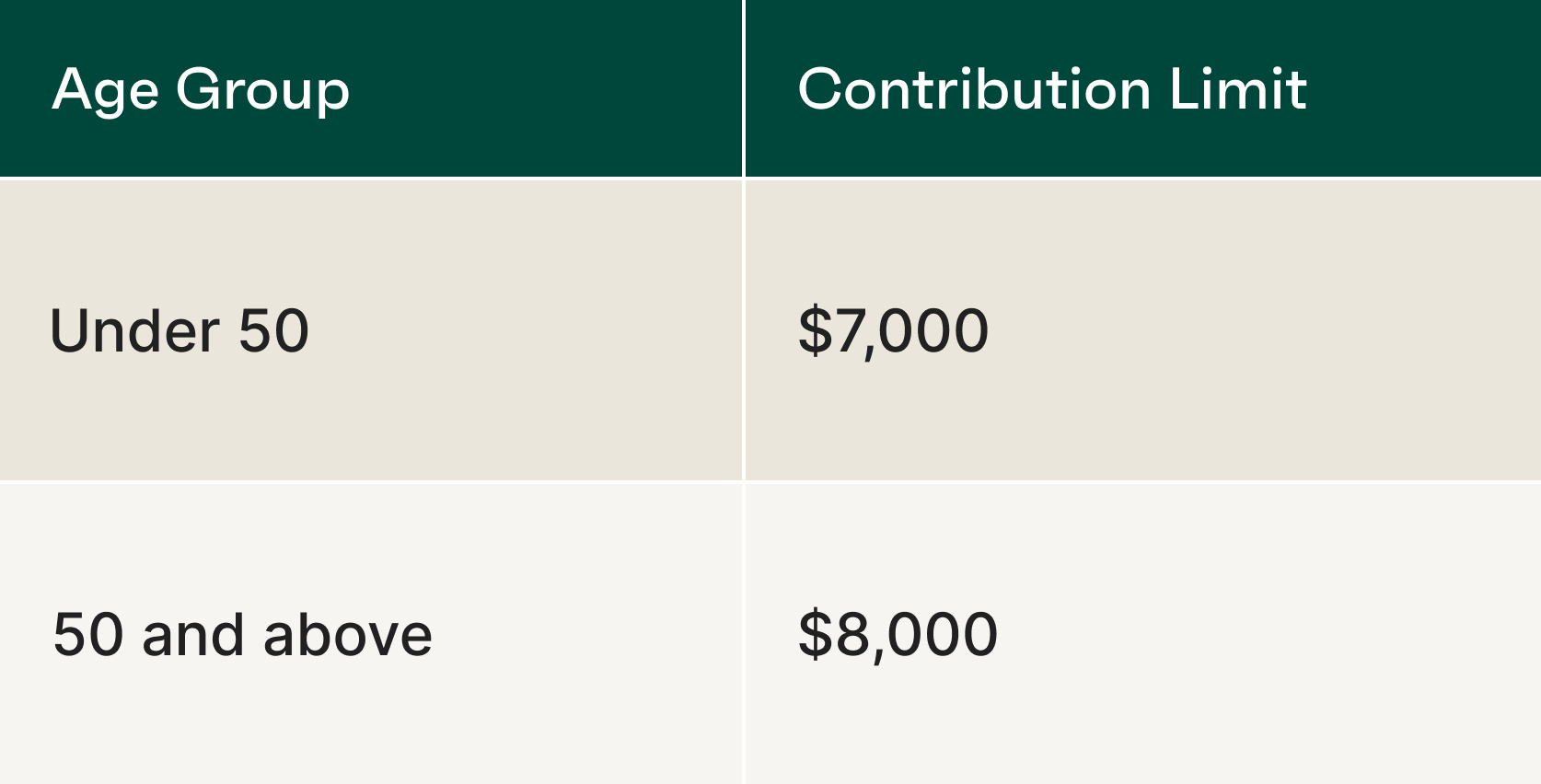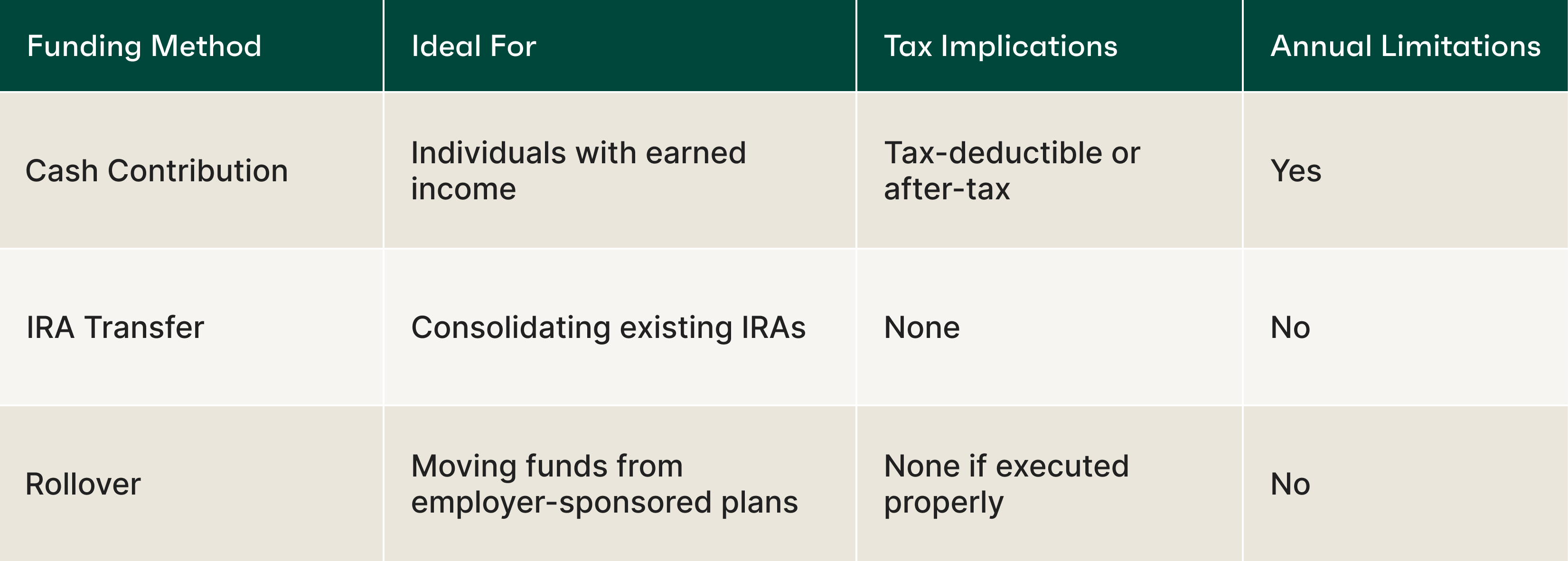Establishing a crypto IRA is a significant step toward diversifying retirement portfolios with digital assets.
However, understanding the various methods to fund such an account is equally crucial. Each funding option—cash contributions, IRA transfers, and rollovers—has distinct rules, benefits, and considerations.
This blog explores these three primary methods, providing clarity on when each is most appropriate for investors.
Cash contributions: building your crypto IRA with earned income
Cash contributions involve depositing funds from personal bank accounts into a crypto IRA. These contributions are subject to annual limits set by the IRS and are ideal for individuals with taxable earned income.
Key details:
- Eligibility: Requires taxable earned income (e.g., wages, self-employment income).
- Contribution limits for 2025:

Deadline: Contributions must be made by April 15, 2026, for the 2025 tax year.
Note: Contributions exceeding the annual limit may incur IRS penalties.
This method suits investors seeking to make regular, tax-advantaged contributions to their retirement accounts.
IRA transfers: moving funds between IRAs without tax implications
An IRA transfer involves moving funds directly from one IRA to another, maintaining the tax-deferred status of the assets. This method is beneficial for consolidating retirement accounts or shifting funds to a crypto-focused IRA.
Key Details:
- Process: Direct transfer between custodians without the investor taking possession of funds.
- Frequency: Unlimited transfers allowed per year.
- Tax Implications: No taxes or penalties if executed correctly.
Note: Transferring between different types of IRAs (e.g., Traditional to Roth) may have tax consequences.
IRA transfers are ideal for investors looking to consolidate retirement savings or move funds into a crypto IRA without triggering taxable events.
Rollovers: transitioning funds from employer-sponsored plans
Rollovers enable investors to move funds from employer-sponsored retirement plans, such as 401(k)s, into a crypto IRA.There are two types: direct and indirect (60-day) rollovers.
Direct Rollovers:
- Process: Funds are transferred directly from the employer plan to the IRA custodian.
- Tax Implications: No taxes or penalties incurred.
Indirect (60-Day) Rollovers:
- Process: Investor receives the funds and must deposit them into an IRA within 60 days.
- Tax Implications: Failure to deposit within 60 days results in taxes and potential penalties.
Note: Only one 60-day rollover is permitted per 12-month period.
Rollovers are suitable for investors transitioning from employer-sponsored plans to self-directed crypto IRAs, allowing for continued tax-deferred growth.
Comparing CryptoIRA funding methods in 2025

Note: Consulting a tax advisor is recommended to understand the implications of each funding method.
Selecting the appropriate funding method depends on individual financial circumstances and retirement goals.
Common funding mistakes to avoid
Several common mistakes can undermine effective crypto IRA funding strategies:
- Missing contribution deadlines: Failing to contribute by tax filing deadlines for previous year eligibility
- Exceeding contribution limits: Over-contributing across multiple IRA accounts
- Improper rollover execution: Missing 60-day deadlines or triggering unnecessary withholding
- Inadequate documentation: Poor record-keeping for tax reporting and compliance
- Emotional timing decisions: Making funding decisions based on short-term market movements
Avoiding these mistakes helps ensure funding strategies support rather than undermine retirement objectives.
Funding a crypto IRA with Alto CryptoIRA®
Alto CryptoIRA® supports all three funding methods — cash contributions, IRA transfers, and rollovers — providing flexibility for investors. The platform integrates with Coinbase for cryptocurrency trading and offers FDIC-insured cash storage through BankProv.
For retirement investors considering cryptocurrency exposure, understanding these funding options enables more effective strategy implementation aligned with broader financial planning objectives. The optimal approach depends on individual circumstances, existing retirement assets, and long-term wealth accumulation goals.





